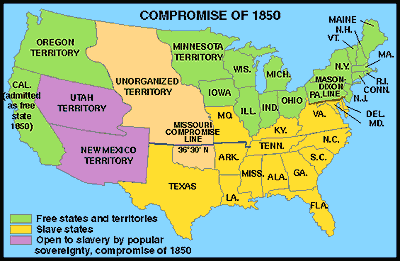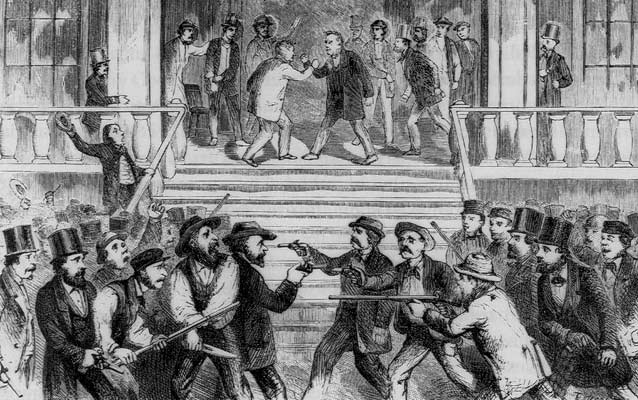Thursday, March 19, 2015
The Election of 1860
For the past week in history class we have been looking into the Election of 1860 and asking ourselves how the results of this election were representative of the country's deep divisions over slavery. To answer this, we did several activities that answered the question. First, we looked at a map of the results of the Election of 1860. This map showed the major division between the north and south on whether slavery should continue in the U.S. We then viewed several primary source images and took notes on how they help tell the story of the Election of 1860 and secession. Finally, we used these notes to create a storyboard video to help answer our essential question of how the results of the Election of 1860 were representative of the country's deep divisions over slavery.
Thursday, March 12, 2015
The Statistics and Strategies of the Civil War
After looking into the factors building up to the Civil War, our history class now moves into the war itself. To thoroughly analyze the war, we have looked into the statistics and strategies used by both the north and the south in their attempts to win the war. After learning this information, we created info graphics to document these statistics.
Thursday, March 5, 2015
The Elephant That Caused the Civil War
Lately in history class we have been looking into the causes of the civil war. Slavery was one of the most enormous problems between the north and the south, and our job was to try and answer the question of why slavery was the “elephant in the room” for American politics in the early 19th century. In order to answer this question, we analyzed several aspects of the growing ignorance of the problem of slavery in the early 19th century and made a timeline of these events. These pieces of proof were the Compromise of 1850, the Gadsden Purchase, the Kansas-Nebraska Act, “Bleeding Kansas”, The Dred Scott Decision, the Lincoln-Douglas debates, and John Brown’s Raid. I will be using proof from the Compromise of 1850, the Gadsden Purchase, the Kansas-Nebraska Act, and “Bleeding Kansas” to answer the essential question.

 The most pertinent factor to slavery being the elephant in the room for U.S. politics in the early 19th century is the fact that unorganized territory would be made into states, and their state of being either free or supportive of slavery would be decided upon population of these states. In this way, more slave owners would be attracted to this land for the chance to extend their property and gain wealth in doing so, therefore subtly supporting slavery in this matter, while still giving non slavery a say. Also in the Compromise of 1850, the slave trade was abolished in Colombia, Washington however slavery itself was not abolished. Citizens in the U.S. were also required to assist in the recovery of slaves. This attempt to please both supporters and non supporters of slavery further proves that slavery was the elephant in the room for American politics in the early 19th century. The US paid $15 million for all of Nevada, California, Utah, and much of Arizona and New Mexico in the Treaty of Guadalupe Hidalgo. Concerning the Gadsden Purchase, the US paid $10 million for a much smaller strip of land known as the Gadsden Purchase only 5 years later. The reason for the huge price difference per square mile was that the U.S. planned to use the purchased land for a transcontinental railroad. This action supported pro slavery advocates because that land would eventually be settled by, most likely, wealthy slave owners in hopes of expanding their land and money. The Kansas-Nebraska Act did just this. The Compromise of 1850 is essentially overturned in the creation of this act. Both slave owners and anti slavery advocates were happy with this. As a result of this, anti and pro slavery settlers swarm Kansas and set up 2 capitals, 1 for pro slavery and 1 for anti slavery. The anti slavery capital was burned down. John brown, a heavily anti slavery advocate, went to the pro slavery capital and killed many people. This chaos was known as “Bleeding Kansas”. This assisted pro slavery advocates because John Brown’s merciless killing gave the anti slavery advocates a bad reputation. This violence concerning slavery further proves that slavery was the elephant in the room for politics in the early 19th century.
The most pertinent factor to slavery being the elephant in the room for U.S. politics in the early 19th century is the fact that unorganized territory would be made into states, and their state of being either free or supportive of slavery would be decided upon population of these states. In this way, more slave owners would be attracted to this land for the chance to extend their property and gain wealth in doing so, therefore subtly supporting slavery in this matter, while still giving non slavery a say. Also in the Compromise of 1850, the slave trade was abolished in Colombia, Washington however slavery itself was not abolished. Citizens in the U.S. were also required to assist in the recovery of slaves. This attempt to please both supporters and non supporters of slavery further proves that slavery was the elephant in the room for American politics in the early 19th century. The US paid $15 million for all of Nevada, California, Utah, and much of Arizona and New Mexico in the Treaty of Guadalupe Hidalgo. Concerning the Gadsden Purchase, the US paid $10 million for a much smaller strip of land known as the Gadsden Purchase only 5 years later. The reason for the huge price difference per square mile was that the U.S. planned to use the purchased land for a transcontinental railroad. This action supported pro slavery advocates because that land would eventually be settled by, most likely, wealthy slave owners in hopes of expanding their land and money. The Kansas-Nebraska Act did just this. The Compromise of 1850 is essentially overturned in the creation of this act. Both slave owners and anti slavery advocates were happy with this. As a result of this, anti and pro slavery settlers swarm Kansas and set up 2 capitals, 1 for pro slavery and 1 for anti slavery. The anti slavery capital was burned down. John brown, a heavily anti slavery advocate, went to the pro slavery capital and killed many people. This chaos was known as “Bleeding Kansas”. This assisted pro slavery advocates because John Brown’s merciless killing gave the anti slavery advocates a bad reputation. This violence concerning slavery further proves that slavery was the elephant in the room for politics in the early 19th century.
Overall, the growing problem of slavery took hold of the country and proved to be an even bigger problem than people had imagined. Politicians’ brushing it off and pretending it wasn't a problem only proved to worsen the problem, ultimately resulting in the deadliest war in America’s history, the Civil War.
Sources:
http://www.ushistory.org/us/30d.asp
http://cowpuncher.library.arizona.edu/history.htm
http://georgiainfo.galileo.usg.edu/gastudiesimages/Kansas-Nebraska%20Act%201.htm
http://www.nps.gov/fosc/learn/education/classrooms/bklesson.htm
Subscribe to:
Comments (Atom)

